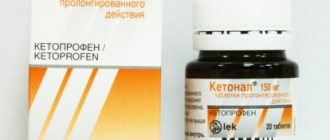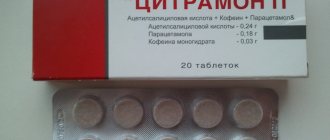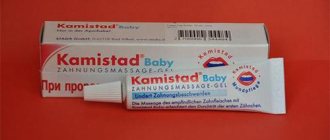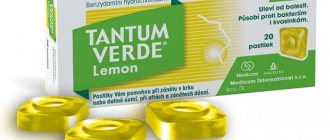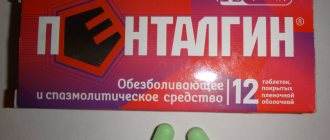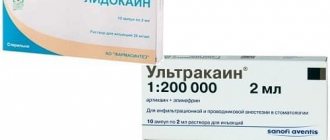During surgeries and other painful procedures, doctors provide pain relief. Thanks to anesthetics, the movement of nerve impulses along the nerve endings is blocked, resulting in the elimination of pain. The most effective drugs are Lidocaine and Novocaine.
When performing surgical operations and other painful procedures, doctors provide pain relief with Lidocaine or Novocaine.
What is the difference
To find out the difference between drugs, a comparison is required. Lidocaine is an amide compound, Novocaine is an ester compound. Esters are unstable in solutions, and when they enter the body they quickly disintegrate. Hydrolysis products often provoke allergic reactions. Amides are relatively stable and degrade slowly. In this case, allergies rarely occur.
Lidocaine differs from Novocaine in its strong analgesic effect. It is available in the form of a solution for injections, eye drops, spray, gel and transdermal patch for topical use. Novocaine has a moderate analgesic effect. It is produced in the form of injections in ampoules, rectal suppositories and infusion solution. In addition, the effects of this drug do not last long.
Lidocaine is characterized by antiarrhythmic properties, effectively anesthetizes tissue, and interacts well with other anesthetics.
Lidocaine is characterized by antiarrhythmic properties, effectively anesthetizes tissue, and interacts well with other anesthetics. The drug rarely causes side effects. Novocaine has a vasoconstrictor effect, improves blood microcirculation and reduces myocardial excitability. It often leads to the development of negative reactions in the body.
The dosage of both medications is determined by the doctor, since an overdose can cause apnea, seizures, and even coma.
Lidocaine release forms and composition
Lidocaine is available in three forms:
- in ampoules;
- in the form of a gel;
- in the form of carpules;
- in the form of a spray.
Lidocaine in 2% ampoules of 2 ml for anesthesia
Composition: 1 ml of solution contains 20 mg lidocaine hydrochloride, 6 mg sodium chloride, water for injection. Available in ampoules of 2 ml.
This anesthetic once replaced novocaine, and was several times stronger than it. You need to understand that novocaine has practically no effect in inflamed tissues during suppuration. The effect of lidocaine does not depend on the presence or absence of inflammation.
Typically, a dose of 4-5 ml of lidocaine is used for anesthesia in dentistry (if lidocaine is used without the addition of adrenaline).
The duration of action from the moment of injection is from 30 to 90 minutes, which depends on numerous factors: the speed of blood flow, which washes the anesthetic out of the tissues, the type of anesthesia (in the upper jaw, anesthesia lasts significantly less than in the lower jaw with conduction anesthesia).
However, now we can safely say that lidocaine, like novocaine, are anesthetics of the past. Now it has been replaced by longer-lasting and deeper-acting anesthetics based on Articaine. These anesthetics include, for example, Ultracain, Septanest, Ubistezin and others. These anesthetics are several times stronger than lidocaine, and their duration of action is also several times longer.
The undoubted advantages of lidocaine include:
low cost, which makes it a good free anesthetic in government clinics (10 ampoules cost about 40 rubles in a pharmacy),
antiarrhythmic effect on the heart, which makes it the drug of choice for the treatment and removal of teeth in patients with cardiac arrhythmias.
Which is better - Lidocaine or Novocaine
To find out which drug is better to use - Lidocaine or Novocaine, the doctor assesses the patient’s condition and situation. The first drug has a profound analgesic effect. Compared to other powerful anesthetics, such as Ultracaine, Lidocaine shows an average effect. However, it has a stronger effect in dental treatment than Novocain. The latter medication is often used in situations where rapid and long-term pain relief is not required.
Lidocaine is prescribed not only for anesthesia.
The drug increases the permeability of cells to potassium, as a result of which the penetration of sodium is blocked. Thanks to this quality, the medicine is used during heart surgery and myocardial infarction.
Which is stronger
If a strong pain reliever is required, lidocaine is used. It begins to act quickly and has a long lasting effect.
The use of lidocaine in dentistry
Lidocaine belongs to the chemical properties of amides. It has a deep analgesic effect. When compared with other existing anesthetics, lidocaine has an average effect on toothache. But it is stronger than the commonly used novocaine. It is these named drugs that are always used in public dental clinics.
The history of the use of painkillers is divided into two periods: before the present day and after. Today, more effective drugs are used as painkillers than before. Medicines that were previously used as anesthesia are outdated and have lost their relevance.
During the action of lidocaine, a person feels a complete loss of sensitivity in a particular area (where the injection was given).
Thanks to the injection, the pain signal entering the brain is blocked. The patient stops feeling pain and therefore begins to behave calmly. In turn, the doctor can carry out a number of surgical and therapeutic procedures through which the disease is cured. All procedures and manipulations in this case take place quickly, without complications, with high quality, correctly and in the required volume.
Some dental procedures were previously performed without anesthesia. Therefore, people were terribly afraid of the dentist's office, delaying the visit until the last stage. Today there is no such thing. The patient knows that in the hospital he will be given an anesthetic injection and the procedure will be almost painless. More and more people are visiting dentistry at the right time. Now a number of complications can be avoided.
Lidocaine in various forms is used in dentistry for anesthesia and pain relief.
Has a local anesthetic effect. Promotes vasodilation without tissue irritation. It is evenly distributed over the treated area for a short period of time.
Used in the treatment of the following dental diseases:
- tooth extraction;
- gingivitis;
- painful teething;
- irritation of the mucous membrane due to dentures;
- stomatitis;
- removal of tartar;
- opening of cystic formations.
In dentistry, it is mainly used in ampoules. In other forms it can be used for toothache at home.
Can I take it at the same time?
It is forbidden to mix Lidocaine and Novocaine together in one syringe. The resulting product will be not only an anesthetic. It begins to have a strong effect on the central nervous system, leading to hallucinations, dizziness, convulsions, feelings of fear, a sharp drop in blood pressure and respiratory arrest.
Novocaine must not be mixed with Lidocaine.
It is allowed to use one medicine for an injection, and the other, for example, in the form of suppositories or ointments. In addition, Lidocaine and Novocaine in the form of an injection can be used, but at intervals of many hours from each other. Particular care must be taken if pain relief is performed at home.
Characteristics of drugs
The presented drugs come from the group of local anesthetics and are characterized by almost the same chemical composition. Taking into account the type of intermediate chain, the duration of action of the presented solutions will vary. According to the same criteria, local anesthetics are classified into esters and amides.
Novocaine is an ether, and Lidocaine is an amide. From this moment, the main differences between the two drugs begin: the esters themselves exhibit high instability, being part of the solution, and when they enter the patient’s body, they begin rapid hydrolysis (under the influence of water, the active substance begins to disintegrate). The final hydrolysis products can trigger the development of allergies.
Amides, in turn, are more stable and take a very long time to break down, so the chances of an allergic reaction are much lower.
After administration, a small concentration of Lidocaine and Novocaine is excreted through the urinary canal, and the rest disintegrates directly inside the body (Lidocaine disintegrates under the influence of liver enzymes) and is excreted.
The required doses of both solutions are determined only by the attending physician, who takes into account the individual characteristics of each patient. It is not advisable to use local anesthetics on your own, because in case of an accidental overdose, convulsive seizures, respiratory arrest and even coma may develop.
Contraindications for the use of Lidocaine and Novocaine
Contraindications to the use of Lidocaine:
- severe liver dysfunction;
- AV block II and III degrees;
- SSSU in elderly patients;
- severe forms of chronic heart failure;
- cardiogenic shock;
- severe bradycardia;
- infection of the intended injection site;
- arterial hypotension;
- shock;
- heavy bleeding.
Novocaine is prohibited in case of excessive sensitivity to the components of the drug.
Side effects from Lidocaine and Novocaine
Lidocaine may cause the following side effects:
- motor restlessness, weakness, headache, dizziness;
- convulsions, trismus, tremor, auditory and visual disturbances;
- drowsiness, loss of consciousness, nystagmus, numbness of the tongue;
- respiratory paralysis, respiratory arrest, respiratory muscle paralysis, paresthesia, leg paralysis;
- chest pain, collapse, peripheral vasodilation, tachycardia;
- decrease or increase in pressure;
- involuntary defecation, nausea, vomiting;
- itching, urticaria, rash, anaphylactic shock, angioedema;
- when used locally in urology – urethritis, spinal anesthesia – back pain;
- paresthesia and loss of sensitivity of the tongue and lips, hypothermia;
- respiratory depression, even stopping, methemoglobinemia, involuntary urination.
During treatment with Novocain, the following negative manifestations of the body may develop:
- allergic reactions;
- hives;
- weakness;
- dizziness;
- collapse;
- arterial hypotension;
- anaphylactic shock.
The main differences between lidocaine and ultracaine
Ultracaine and lidocaine are two of the most discussed drugs for local anesthesia.
They are almost always opposed to each other. But opinions about which anesthetic is better are diametrically opposed. Some consider lidocaine to be an effective, reliable and time-tested drug, while others consider it an outdated remedy that has no place in everyday practice. Ultracaine also has not earned an unambiguous positive assessment: rave reviews about the effectiveness of anesthesia are diluted by numerous complaints about side effects.
Research shows that, all other things being equal, the analgesic effect of ultracaine is stronger and toxicity is lower. However, this does not mean that lidocaine should be completely written off. With the right choice of anesthesia technique, it can achieve good analgesia and avoid side effects. On the other hand, errors in determining indications and errors in the technique of medical manipulation can occur.
Ultracaine is a local anesthetic, which is used for the purpose of conduction or infiltration anesthesia.
Ultracaine is a mixture of the anesthetic articaine (hydrochloride) and epiphrine (adrenaline tartrate), as a result of which it has a high analgesic effect.
When ultracaine is administered, the anesthetic penetrates through the membrane into the nerve fiber, where, interacting with the slightly alkaline environment of the body tissues, a base with lipophilic properties is released. In this way, interaction with nerve tissue receptors is carried out, during which access for the Na+ ion into the cell is blocked during the depolarization phase, which, as a consequence, blocks the conduction of an impulse along the nerve fiber. The onset of the anesthetic effect occurs immediately after the administration of ultracaine, the period of exposure lasts from 1 to 5 hours.
Novocaine, also known as procaine, is a drug with a moderate anesthetic...
0 0
Ultracaine and lidocaine are two of the most discussed drugs for local anesthesia. They are almost always opposed to each other. But opinions about which anesthetic is better are diametrically opposed. Some consider lidocaine to be an effective, reliable and time-tested drug, while others consider it an outdated remedy that has no place in everyday practice. Ultracaine also has not earned an unambiguous positive assessment: rave reviews about the effectiveness of anesthesia are diluted by numerous complaints about side effects.
Local anesthetics
Research shows that, all other things being equal, the analgesic effect of ultracaine is stronger and toxicity is lower. However, this does not mean that lidocaine should be completely written off. With the right choice of anesthesia technique, it can achieve good analgesia and avoid side effects. On the other hand, errors in determining indications and errors in the technique of medical manipulation can...
0 0
It is rare that dental surgery takes place without pain. And this is the most pressing problem in dentistry today. The technique of local anesthesia began to be used more than a century ago. At the end of the 18th century, cocaine was used for these purposes, and novocaine was introduced in 1906. Of course, it was not very effective, but it significantly reduced the intensity of the unpleasant sensations.
It was the low efficiency that forced the search to continue. This is how lidocaine was born. It was much stronger, but it did not satisfy the practicing doctors, since complete pain relief was still not possible to achieve. Periodic allergic reactions were observed to novocaine, and lidocaine turned out to be more toxic than its predecessor.
In 1976, a new drug appeared - ultracaine. This was a breakthrough in dentistry. An anesthetic from the amide group, as it turned out, outperformed both novocaine (six times) and lidocaine (twice). In addition, it is less toxic and is able to penetrate bone and connective tissues...
0 0
Lidocaine and novocaine. What is the best pain reliever?
To determine which of the drugs, novocaine or lidocaine, is a stronger pain reliever, you need to understand the concepts. Lidocaine is a powerful local anesthetic that is used for local anesthesia in dentistry, ophthalmology, and otolaryngology. The analgesic effect of this remedy is much higher than that of novocaine. Lidocaine is used only for local anesthesia. This substance is highly toxic. Therefore, doctors use this drug very carefully in their profession. Novocaine is a drug with moderate anesthetic activity. It is used in medicine for local anesthesia. But unlike lidocaine, the effect of novocaine is short-lived. Most often, novocaine is used in dentistry, urology and surgery. After absorption into the blood, novocaine has an anti-inflammatory, analgesic, and antitoxic effect. Novocaine relieves smooth muscle spasms and reduces...
0 0
Ultracaine is a modern remedy for local anesthesia. Widely used in dentistry due to the rapid achievement of an anesthetic effect, with the introduction of a minimal amount, and the duration of action. The drug is well accepted by tissues, but has certain side effects and contraindications.
Ultracaine is one of the most effective anesthetics in dentistry, with a strong effect and a minimum of side effects.
It is used for infiltration anesthesia during dental procedures that cause significant pain. The drug is used to remove the dental nerve, during orthopedic manipulations and surgical interventions.
The pharmacodynamic effect of the drug is 2 times greater than lidocaine and 6 times greater than novocaine. The toxic effect of ultracaine is 2 times lower than the toxicity of lidocaine.
The most important advantages are the high ability to penetrate the connective and...
0 0
"Trakain" - without pain and almost without fear: all about the drug
Types of Ultracaine In what situations is Ultracaine used in dentistry? Methods of administering this anesthetic Pain relief in pregnant women Contraindications for use Symptoms of overdose How much does pain relief cost?
Ultracaine is an anesthetic of the articaine series. Previously, Novocaine was used in dentistry for pain relief; it is still used in some public clinics, but it is very toxic. And Ultracaine has lower toxicity compared to Novocaine and Lidocaine, as well as higher efficiency (5 times more effective than Novocaine and 2 times more effective than Lidocaine). The type of Ultracaine is indicated in the instructions for use.
Types of Ultracaine
There are 3 types of this anesthetic:
Ultracaine D (form of the drug without adrenaline). Well suited for patients with bronchial asthma and other allergic diseases. The drug does not contain the preservative sodium disulfite, therefore...
0 0
HOW TO CHOOSE A LOCAL ANESTHETIC FOR EFFECTIVE AND SAFE PAIN RELIEF (Part 1)
Yu. G. Kononenko, Ph.D., Assoc. IFNMU
Characteristics of local anesthetics
Local anesthesia is the primary means of pain relief during an outpatient dental appointment. The following requirements apply to local anesthetics:
They must have a strong analgesic effect, easily penetrate into tissues, remaining there as long as possible; have low toxicity and, accordingly, cause a minimum number of general and local complications. .
In recent years, about 100 local anesthetics have appeared, mainly based on lidocaine, mepivacaine, articaine and bupivacaine hydrochloride. This makes it possible to choose the most effective and safe drug for pain relief.
Local anesthetics are divided into two based on their chemical structure...
0 0
10
UP UFPTPOSH GEOFTBMSHOPK Y RETYZHETYYUEULPK OETCHOPK UYUFENSH: ZPMPCHOBS VPMSH, ZPMPCPLTHTSEOYE, UPOMYCHPUFSH, UMBVPUFSH, DCHYZBFEMSHOPE VEURPLPKUFCHP, OBTTHYEOYS UPBOYS, CHRMPFSH DP EZP RPFETY, UKhDPTTPZY, FTYYN, FTENPT, ЪTYFEMSHOSHCHE Y UMHIPCHSHCHE OBTHYEOYS, RPFETS ЪTEOYS, RPNHFOEOYE CH ZMBBI, DYRMPRYS, OYUFBZN, UYODTPN LPOULZP ICHPUFB (RBTBMYU OPZ, RBTEUFEYY), RBTBMYU DSHHIBFEMSHOSHHI NSHCHYG (YUBEE TBCHYCHBEFUS RTY UHVBTBIOPYDBMSHOPK BOEUFEYYY), VMPL NPFPTOSHCHK Y YUKHCHUFCHY FEMSHOSCHK. UP UFPTPOSH uuu: UOTSEOYE bd, LPMMBRU (RETYZHETYYUEULBS CHBPDYMBFBGYS), VTBDYLBTDYS, BTYFNYY, VPMSH CH ZTHDOPK LMEFLE. UP UFPTPOSH NPYUECHSHCHDEMYFEMSHOPK UYUFENSCH: OERTPYCHPMSHOPE NPYUEYURKHULBOYE. UP UFPTPOSH RYEECHBTYFEMSHOPK UYUFENSH: FPYOPFB, TCHPFB, OERTPYCHPMSHOBS DEZHELBGYS. UP UFPTPOSH LTPCHY: NEFZENPZMPVYOENYS. UP UFPTPOSCH PTZBOPC DSCHIBOYS: DYUROP, BROP. bMMETZYUEULYE TEBLGYY: ЪХД ЛПЦІ, ЛПЦОВС УШЧРШ, BOZYPOECHTPFYUEULYK PFEL, DT. BOBZHIMBLFYUEULYE TEBLGYY (YUBEE BOBZHIMBLFYUEULYK YPL), LTBRYCHOYGB (ABOUT LPTSE Y UMYYUFSHCHI PVPMPYULBI). rTPYUYE: ZYRPFETNYS, YNRPFEOGYS;…
0 0
12
The most common local anesthetics include lidocaine, bupivacaine, novocaine, dicaine, and marcaine.
NOVOCAINE (NOVOCAINUM)
Synonyms: Neocaine, pancain, procaine, Syncaine. Low toxicity and good breadth of therapeutic action make it most suitable for infiltration anesthesia. Novocaine is of little use for superficial anesthesia techniques, since it is poorly absorbed through the mucous membranes. A number of patients have increased sensitivity to novocaine, so intoxication phenomena are possible even when using therapeutic doses. The process of hydrolysis of novocaine with the formation of para-aminobenzoic acid in the body is disrupted, especially in malnourished patients. Therefore, in such patients, therapeutic doses are toxic. Early clinical signs of intoxication are dizziness, agitation, and decreased blood pressure. Subsequently, weakness, nausea, circulatory disorders up to collapse, respiratory distress with the development of...
0 0
13
Dental treatment during pregnancy can be accompanied by certain difficulties.
First of all, it is advisable to refrain from serious interventions in the first trimester of pregnancy.
Treatment of shallow caries can be carried out in the early stages, but sometimes situations occur when complex treatment with anesthesia is necessary.
When is pain relief needed?
Anesthetic drugs for dental treatment in pregnant women are necessary in the following cases:
Your dentist will tell you about dental treatment during pregnancy.
What can and cannot be done for expectant mothers?
Lidocaine has a large number of contraindications, including difficulty breathing, muscle spasms and decreased...
0 0
15
How to use
The dosage of both medications is determined only by a doctor. Lidocaine is administered intravenously in the smallest dose that allows you to achieve the desired effect. Its maximum amount is 0.3 g, Novocaine - 0.6 g.
In the treatment of heart disease and endarteritis, Novocaine is administered intramuscularly.
The course of therapy includes 12 injections. If such a need arises, it is repeated 4 times a year.
Sometimes antibiotics, such as Ceftriaxone, are administered intramuscularly or intravenously. In this case, the patient feels severe pain during injection and for some time after. Therefore, it is recommended to dilute antibacterial drugs with anesthetics. It is undesirable to use Novocaine for these purposes, since anaphylactic shock may develop. It is best to dilute Ceftriaxone with Lidocaine.
Reviews
Marina, 36 years old, Samara: “I am allergic to Novocaine, so I remove teeth only with Lidocaine. It relieves pain better, acts quickly and comes off easily. When I was breastfeeding, I had to resort to another remedy, because Lidocaine is prohibited in this case. It was also used in gynecology for local anesthesia when taking a biopsy for oncology.”
Stepan, 46 years old, Chelyabinsk: “I suffer from cervicothoracic osteochondrosis. When an exacerbation occurs, even analgesics cannot relieve the pain. In this case, I use Novocaine patches. Relief comes quickly and I fall asleep peacefully. In addition, I use novocaine suppositories for hemorrhoids.”
